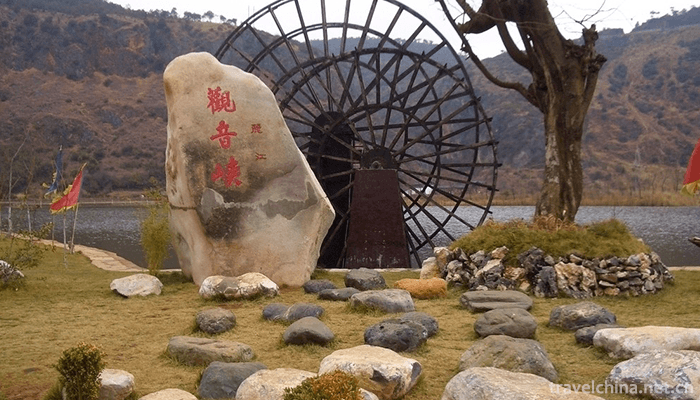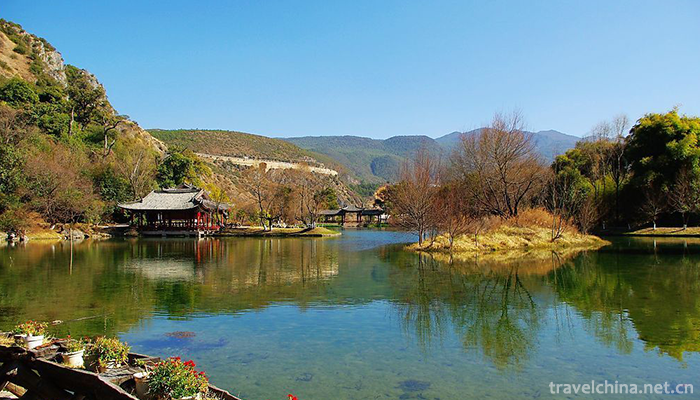Guanyin Gorge Scenic Area
Guanyin Gorge Scenic Area
Guanyinxia scenic spot is the entrance of Yulong Pass, one of the six major parks of Lijiang Bazi. It is located at the "Yulong Pass" of the three major parks of Lijiang Bazi and is known as "the first scenery of Lijiang". Lijiang Guanyin Gorge is a scenic area based on natural scenery such as mountains, canyons, forests and lakes, and integrated with the ancient tea-horse street, Naxi villages, folk customs, religious customs and other humanistic landscapes. Manxiong Guanqiutang Road and long tea-horse-dian Tibetan feelings are the portrayal of Lijiang Guanyin Gorge. It is the first dangerous fortress on the Dian-Zang Line of the ancient tea-horse road. Xu Xiake entered Lijiang from this point. Jiang, Qiutangguan is described as "Lijun Lock Key". When entering this "Lijun Lock Key", he enters the gate of Lijiang. Only when entering this gate can he count as coming from the main gate to Lijiang.
Tourist route
Starting from the ancient city of Lijiang, we enter the scenic spot of Guanyin Gorge in Lijiang in half an hour. First, we arrive at the "Tea-Horse Road Point" at the entrance. The Tea-Horse Road is a non-governmental international trade passageway in southwestern China, which takes the Ma Gang as the main means of transportation. It originated from the tea-horse market in the southwestern frontier of ancient China. It flourished in Tang and Song Dynasties and flourished in Ming and Qing Dynasties. It can be Guanyin Gorge is the only crossing and military fortress of the ancient tea-horse road from Lijiang to Tibet along the Yunnan-Tibet line in history. After the Tea-Horse Road and Mujiaqiao, we arrived at Mujia's other courtyard, which was the tax office set up by the Civil Chieftain in that year. Mujia other courtyard fully embodies the architectural style of Naxi's three halls, one shining wall, four-in-five courtyard, elegant six-in-one door and standard honeycomb wall. Walking on the ancient street of tea horse, one can't help but think of the brilliance of the Dama Gang in the past. The Tianxiang Pagoda, which is a unique sacrificial pagoda for the Naxi people, can also be seen on the way forward with small stones, one by one, bonded by stacks and bases; the Xiakating Pavilion where Xu Xiake once stayed; and the Tibetan Academy of Culture with a strong religious atmosphere. Walking through the busy market, the green gradually becomes dense, green and dark, fragrant with wild flowers; weeping willows are reflected in the quiet lake water, up and down the sky, 10,000 hectares.
The ancient Yunnan-Tibet Teahouse is situated between the green bamboos and willows, which stands out against the background of the lake. Passing through a dense bamboo forest is a mountain tunnel about 385 meters long, which can be passed by electric train. "Heavy mountains and rivers have no way out, bright willows, dark flowers and another village", "Tanyue does not follow the water, the wind from the gorge and the tide of people" crossed the tunnel, more than 100 meters ahead is Guanyin gorge, there are stone tablets: "Lijiang Guanyin gorge" gorge quiet, peaks stand high, and the sound of water is heard. Turning around the peak, I saw a waterfall flying down, very fast and arrows, there is indeed the potential of the Milky Way to fall for nine days. This is the Guanyin Waterfall in Lijiang. There are standing statues of Guanyin in the caves beside it. So it is called Guanyin Gorge. Guanyin Waterfall is the end, with the rolling torrent, treading on the clutch and returning to the glory, climbing along the stone level, only to see Hengke shelter, in the daytime dusk, sparse intersection, sometimes see the sun, fantastic flowers and plants, fighting beautiful, fresh mountain breeze, refreshing. Undoubtedly, today's Guanyin Gorge is still the Guanyin Gorge in Xu Xiake's eyes. Its courtyard, its alleys, its rivers and its distant Yulong Snow Mountain all contain a deep and ancient history. But today's Guanyin Gorge is no longer the Guanyin Gorge in the past. It bid farewell to the vast and desolate West Yunnan Post Road and bid farewell to the murkiness. Chaotic closed-door self-defense, today's Lijiang has opened up a road to the world outside the mountains.
Layout of scenic spots
Lijiang is located on the main road leading to Yunnan-Tibet, Nujiang and Bashu. It is an important place in the transition zone between Yunnan and Sichuan in terms of geographical location. It has become the largest transit station and distribution center for trade between Yunnan and Tibet. Qihe Qiutangguan is located in the key passage of Lijun, where the merchants and businessmen from Malayan Band gather. Therefore, in those days, Lord Mu cut the manor here and guarded the danger of the town gate, which was for the purpose of "Mujia Beyond the Courtyard". The Mujia Beiyuan fully embodies the architectural style of Naxi's three halls, one shining wall, four-in-five patio, elegant six-in-one door and standard honeycomb wall. Walking on Tea Horse Street is reminiscent of the past glory of the Dama Gang. Today, there are many old workshops and shops in the ancient street, such as carpenter's shop, cobbler's shop, copper and iron shop, silver shop, inn, pub and shop. Nowadays, these shops have resumed normal business, and also provide a platform for tourists outside Guanyin Gorge to share the original national ecological culture. They display Dongba script works, woodcarving, wood carving, root carving, embroidery, painting and calligraphy in various forms, inheriting the ancient Naxi culture.
Guanyin Gorge Tourism
Yinxia is located in Qihe Township, 17 kilometers southeast of Lijiang City. On the way from Lijiang Airport to Lijiang Ancient City, it is usually on the way to visit Lijiang, or on the way to visit Lijiang when leaving Lijiang.
Guanyin Gorge Scenic Area is mainly composed of Huanglongtan, Tea Horse Cultural Area and Canyon Scenic Area. The main scenic spots in the scenic area are Liangma Bridge, Yunnan-Tibet Tea House, Huanglongquan Waterfall, Guanyin Gorge Waterfall, Xiake Pavilion, Tianxiang Pagoda and Mujiabieyuan. You can take the electric slide in the scenic area. The tube-track electric slide car starts from the tunnel tourist area and goes directly around the mountain. At the entrance of Guanyin Gorge, the total length is 1200 meters, with a drop of more than 30 meters. Tourists can control their own speed. The speed can reach 7 km/h, which is very dynamic. Lijiang Guanyin Gorge Network, beautiful scenery, dangerous terrain, throughout the valley, high errors, many tourists, riding electric taxi tours can not only allow tourists to enjoy the scenery of the valley without excessive physical exertion in the plateau area, but also increase the participation of tourists. Mainly composed of slideways, pulleys and power supply systems, the line is equipped with straight roads, bends and drapes. Tourists take cars from the lower entrance of the tunnel, along the canyon to the upper entrance of the tunnel, empty cars return from the tunnel, and the whole line is a closed loop. Considering the convenience of tourists'sightseeing, combined with natural terrain and modern construction facilities and equipment, it is more convenient and fast to meet the tourists' browsing space at multiple levels. Passengers passing through the cliffs are thrilling and stimulating, meeting the needs of recreation and entertainment, and when they are running on the way, they are ups and downs, complex and changeable, which increases the interest of tourists.









-
2.Weiyang Palace Site in Changan City Han Dynasty
The site of Weiyang Palace in Chang'an City of Han Dynasty, located in the southwestern part of the site of Weiyang District, Xi'an City, Shaanxi Province, was built in the seventh year of Han Gaozu (
Time 2019-01-13 -
3.Longtan Park
Longtan Park is located opposite Longtan Beili District, Dongcheng District, Beijing (Chongwen District), and is currently a national 4A-level tourist park. Longtan Park
Time 2019-02-06 -
4.Shenyang Weipo Skiing Ground
Shenyang Qiaopo International Skiing Resort is located in AAAA Scenic Area of Qiaopo in Shenyang, which is surrounded by mountains in the northeast direction and boundless forest sea.
Time 2019-02-08 -
5.Kazakhstan 62 Kwohner
Kazakhstan 62 Kwohner 62 Kwohner is Kazakh folk classical music, which means "62 suites". It is a comprehensive art mainly composed of instrumental music, accompanied by folk songs, dances,
Time 2019-05-02 -
6.Shui Shui Custom
"Shuishu" is a prototype written by the ancestors of the Shui nationality of the minority nationalities in Southwest China. Shui Shu custom is the formation, development and inheritance of S
Time 2019-06-15 -
7.Tu Costume
Women usually wear embroidered small collar and long slant-skinned shirt. The sleeves are made of red, yellow, orange, blue, white, green and black seven-color cloth rings. They are bright and beautif
Time 2019-06-23 -
8.Xinchang tune
Xinchang tune is one of the ancient opera tunes, also known as "falling out of tune", "Shaoxing high-key" and "Xinchang high-key". With Xinchang as the center, it has spr
Time 2019-07-06 -
9.Xu Wenchangs Story
The story of Xu Wenchang takes the history of the middle and late Ming Dynasty as the background. From the legend story of Xu Wenchang's youth, "Taking things from the pole", it has been tol
Time 2019-07-09 -
10.Mianzhu Hanwang earthquake site
Mianzhu Hanwang earthquake site (Park) is composed of three areas: Dongqi factory area, Dongqi dormitory area and Hanwang town area. It mainly focuses on four themes: digital display platform
Time 2020-11-05 -
11.Leshan peoples life
By the end of 2018, the per capita disposable income of rural residents in Leshan City was 15173 yuan, an increase of 8.9%, and the per capita living consumption expenditure was 12309 yuan, an increase of 9.5%. The per capita disposable income of urban residents
Time 2020-12-17 -
12.History and culture of Yibin
Yibin has 34 world-class, national and provincial scenic spots and 58 national and provincial key cultural relics protection units. Among them, there are seven cave cliff tombs (Eastern Han Dynasty), Jiuzhou tower (Song Dynasty), Daguanlou (Qing Dynasty), etc.
Time 2020-12-18